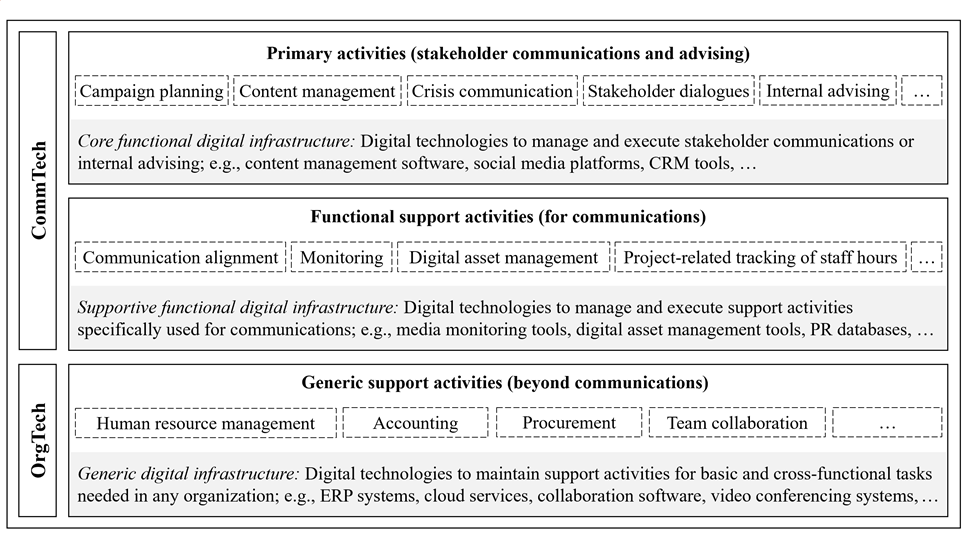Recently, the term “CommTech” (Communication Technology) has entered the professional discourse – inspired by a related debate in marketing, called “MarTech”. The discussion goes beyond the traditional use of digital instruments and platforms, such as social media, websites or intranets for stakeholder communications. But what is the phenomenon of CommTech about, exactly? And how mature are communication departments and agencies in this respect?
A recent research project conducted by Alexander Buhmann from BI Norwegian Business School, Ansgar Zerfass from Leipzig University, and me, aimed to shed light on the state of CommTech. Our main findings are outlined below.
What is CommTech?
To understand CommTech’s emergence and consequences in the profession, we conceptualized the phenomenon of CommTech and developed a theoretical framework. In line with the understanding of CommTech in practice (Arthur W. Page Society, 2021; Weiner, 2021), we propose the following concise definition of the emergent and much-debated concept:
“CommTech are digital technologies provided or used by communications functions or departments to manage and perform primary activities, particularly stakeholder communications and internal advising, or functional support activities such as managing internal workflows for monitoring, content planning, or evaluation” (Brockhaus et al., 2022).
The proposed framework built on previous literature divides digital technologies into three conceptual dimensions: primary activities, functional support activities, and generic support activities. Also included in the framework are organization-wide technologies (OrgTech), which are distinguished from functional digital technologies like CommTech or MarTech.

Figure 1. Dimensions of digitalization in communications
1) CommTech: Core functional digital infrastructure
The core functional digital infrastructure consists of industry-specific software and service solutions for communications, i.e., content management software (e.g., Drupal), social media management tools (e.g., Hootsuite), and relationship management and distribution tools (e.g., Cision Communications Cloud). It supports primary activities directly linked to value creation through communications. They include preparing, creating, and executing stakeholder communications. Another key contribution of communications to corporate success are internal advisory activities such as analyzing and preparing insights, delivering presentations, and considering and discussing relevant issues.
2) CommTech: Supportive functional digital infrastructure
The supportive functional digital infrastructure consists of specific software for the communications profession (e.g., media monitoring tools like Meltwater) or customizable digital tools used for multiple functions (e.g., Adobe Experience Cloud for digital asset management) that support workflows necessary to manage communication in organizations. Such activities include overall planning (aligning communication and business goals) and monitoring, yet also handling digital assets (logos, templates, pictures, videos) as well as tracking staff hours and resources for projects.
3) OrgTech: Generic digital infrastructure
The generic digital infrastructure consists of solutions that are usually provided by IT departments or providers and are not specifically developed or adopted for communications, such as enterprise resource systems for budgeting and sourcing (e.g., SAP software), and video conferencing tools (e.g., Zoom). It supports basic workflows which are needed in any organization for task fulfillment, especially collaboration.
To keep pace with the fast-changing digital environment with a 24/7 information flow and ever-new digital technologies, communication departments and agencies need to build their own digital infrastructure based on their objectives, processes, and resources. The framework presented above can serve as a guideline for reflecting on communication processes and utilizing digital technologies.
How mature is CommTech in communication departments and agencies?
Based on the framework, we conducted a quantitative online survey among 2,664 communication practitioners across Europe addressing CommTech (Zerfass et al., 2021). According to our survey data, the current level of digital maturity of communication departments and agencies is often not viewed as satisfactory by practitioners. 39% assessed their communication department or agency as being “digitally immature” overall.
Looking at the three dimensions outlined above, the respondents assessed the current level of maturity of the supportive functional digital infrastructure (second dimension) as least mature, followed by the core functional digital infrastructure (first dimension) – both dimensions depicting CommTech. Communication departments and agencies weres seen as most experienced in providing collaboration tools for team members (third dimension). While the necessity and potential for digitalization is clearly seen in the profession, sound strategic approaches for a digital transformation of communications are often missing. Strategies and approaches for building a digital infrastructure existed in 54% of the communication units assessed in the sample, but only 32% had routines for selecting software and services.
Our analyses revealed the relevance and effectiveness of strategies for the four components (technology, tasks, structure, and people). All are vital to consider when introducing technologies and raising the digital maturity of communications. Hence, we argue that transformation strategies need to take care of technologies, tasks, structure, and people simultaneously.
Generally, we suggest that both practitioners and scholars understand the digital transformation as a socio-technical change process – as the interplay of technological and human challenges will become more important in the future – and develop a holistic strategic approach when heading towards digitalization of communication processes. The applied perspective allows to rejoin the artificial distinction between a technology (it’s properties, features, outcomes etc.) on one hand, and its context and use on the other hand. Our research favors a view on CommTech as “technology in practice” and “practiced technology”.
References
Arthur W. Page Society. (2021). ComTech guide. Available at: https://commtechguide.page.org/getting-started-in-commtech-from-professional-to-pathfinder/a-new-profession-emerges/ (accessed 28 July 2022).
Weiner, M. (2021). PR technology, data and insights: Igniting a positive return on your communications investment. Kogan Page.
Zerfass, A., Buhmann, A., Tench, R., Verčič, D., & Moreno, A. (2021). European Communication Monitor 2021. CommTech and digital infrastructure, video-conferencing, and future roles for communication professionals. Results of a survey in 46 countries, EUPRERA/EACD.
![]()
 Jana Brockhaus, M.A., is a Research Associate at the Chair of Strategic Communication (Prof. Dr. Ansgar Zerfass) at Leipzig University, Germany. Her research interests include corporate communications, digitalization of communication management, and employee engagement. Most recently, she has been conducting research on the digital transformation of communications and the field of CommTech.
Jana Brockhaus, M.A., is a Research Associate at the Chair of Strategic Communication (Prof. Dr. Ansgar Zerfass) at Leipzig University, Germany. Her research interests include corporate communications, digitalization of communication management, and employee engagement. Most recently, she has been conducting research on the digital transformation of communications and the field of CommTech.



